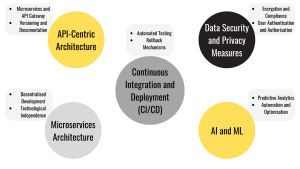Strategies in Bespoke Software Development
Introduction In the fast-paced world of technology, businesses face the dual challenge of scaling their operations to meet growing demands and staying ahead of ever-evolving t...

Introduction
In the fast-paced world of technology, businesses face the dual challenge of scaling their operations to meet growing demands and staying ahead of ever-evolving technological advancements. For companies investing in bespoke software solutions, the strategic pillars of scalability and future-proofing become paramount. In this in-depth guide, we will delve into the future-proofing strategies that underpin the design and bespoke software development, ensuring it not only scales seamlessly with a company’s growth but also remains adaptable to the dynamic landscape of future technological changes.
Understanding Scalability
Scalability is more than just a buzzword; it is the bedrock upon which a software solution’s longevity rests. A scalable bespoke software design anticipates and accommodates growth, ensuring optimal performance as user bases, data loads, and functionalities expand.

- Modular Architecture. A cornerstone of scalability is the adoption of a modular architecture. By breaking down the software into independent, interchangeable modules, development teams gain the flexibility to scale specific components without affecting the entire system. This modular approach simplifies maintenance, accelerates development, and allows for targeted scalability.
- Cloud Integration. Embracing cloud technologies is a game-changer for scalability. Cloud platforms provide the elasticity needed to scale resources on-demand, ensuring that the software can handle increased workloads without the need for significant infrastructure investments. This not only optimises performance but also enhances cost-efficiency.
- Database Optimisation. The scalability of bespoke software heavily relies on the efficiency of its database. Implementing techniques such as sharding, indexing, and caching enhances database performance, ensuring it can handle large volumes of data seamlessly as the user base grows.
Understanding Future-Proofing
Future-proofing is a proactive strategy that goes beyond accommodating current needs. It’s about anticipating technological shifts and ensuring that bespoke software can seamlessly integrate new functionalities, technologies, and innovations as they emerge. Future-proofing safeguards your software investment, preventing it from becoming obsolete in the face of rapid technological evolution.

API-Centric Architecture
At the forefront of future-proofing strategies is the adoption of an API-centric architecture. APIs serve as the conduits for communication between different software components, providing a standardised way to expose and consume functionalities. This approach ensures that bespoke software remains agile, capable of integrating with emerging technologies through well-defined interfaces.
- Microservices and API Gateway: Embracing a microservices architecture alongside an API gateway allows for the creation of independent, manageable services. This not only facilitates easier updates but also enables the integration of new functionalities without disrupting the entire system.
- Versioning and Documentation: Future-proofing through APIs involves careful versioning and documentation. Ensuring backward compatibility and providing comprehensive documentation safeguards against disruptions when upgrading or introducing new API versions.
Microservices Architecture
Beyond the API-centric approach, the adoption of a microservices architecture further future-proofs bespoke software. Breaking down the application into small, independent services allows for greater flexibility, easier updates, and improved scalability.
- Decentralised Development: Each microservice can be developed and deployed independently, fostering decentralised development. This not only accelerates the software development life cycle but also enables teams to work on specific functionalities without impacting the entire system.
- Technological Independence: With microservices, different components can use different technologies. This flexibility allows businesses to adapt to new technologies and languages as they emerge, ensuring that bespoke software remains technologically relevant.
Continuous Integration and Deployment (CI/CD)
Future-proofing is not solely about the architecture; it’s also about the development and deployment processes. Implementing CI/CD pipelines automates testing, integration, and deployment, fostering a culture of rapid and reliable releases.
- Automated Testing: Comprehensive test suites ensure that updates and changes do not introduce bugs or vulnerabilities. Automated testing, integrated into the CI/CD pipeline, validates the software’s integrity, minimising the risk of issues in production.
- Rollback Mechanisms: In the event of unforeseen challenges post-deployment, having rollback mechanisms in place allows for a swift return to a stable version. This mitigates risks associated with adopting new technologies or functionalities.
Data Security and Privacy Measures
As the digital landscape evolves, data security and privacy become increasingly critical. Future-proofing bespoke software involves implementing robust security measures and adhering to evolving compliance standards.
- Encryption and Compliance: Utilise encryption protocols to secure sensitive data. Stay abreast of evolving compliance standards, such as GDPR or industry-specific regulations, and integrate necessary measures into the software architecture.
- User Authentication and Authorisation: Implement secure user authentication and authorisation mechanisms. As new authentication methods emerge, ensure that the software can seamlessly integrate these without compromising security.
AI and Machine Learning Integration
Future-proofing goes beyond adaptability to external technologies; it includes leveraging advancements in artificial intelligence (AI) and machine learning (ML). Integrating AI/ML capabilities into bespoke software positions it at the forefront of innovation.
- Predictive Analytics: Use AI and ML algorithms for predictive analytics, allowing the software to anticipate user behaviour, optimise processes, and provide personalised experiences.
- Automation and Optimisation: Leverage machine learning to automate repetitive tasks and optimise processes. This not only enhances efficiency but also positions the software as a cutting-edge solution in the market.
Conclusion
As businesses embark on the journey of bespoke software development, the fusion of scalability and future-proofing emerges as a strategic imperative. The detailed strategies confidently navigate the evolving technological landscape. By embracing API-centric architecture, adopting a microservices approach, implementing robust CI/CD pipelines, prioritising data security, and integrating AI/ML capabilities, bespoke software becomes a dynamic asset – one that not only scales seamlessly with growth but stands resilient in the face of future technological changes. The journey to future-proofing bespoke software is an ongoing commitment to innovation, adaptability, and excellence, ensuring that your software remains at the forefront of the digital revolution.